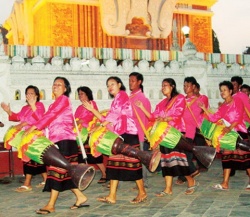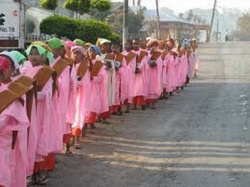Difference between revisions of "Buddhism and Sexism"
m (Text replacement - "authority" to "authority") |
m (Text replacement - "the dharma" to "the dharma") |
||
| (One intermediate revision by the same user not shown) | |||
| Line 24: | Line 24: | ||
On the other hand, the Vimilakirti [[Sutra]] teaches that maleness and femaleness, like other [[phenomenal]] distinctions, are [[essentially]] unreal. "With this in [[mind]], the [[Buddha]] said, ’In all things, there is neither male nor {{Wiki|female}}.’" The Vimilakirti is an [[essential]] text in several [[Mahayana]] schools, including [[Tibetan]] and [[Zen]] [[Buddhism]]. | On the other hand, the Vimilakirti [[Sutra]] teaches that maleness and femaleness, like other [[phenomenal]] distinctions, are [[essentially]] unreal. "With this in [[mind]], the [[Buddha]] said, ’In all things, there is neither male nor {{Wiki|female}}.’" The Vimilakirti is an [[essential]] text in several [[Mahayana]] schools, including [[Tibetan]] and [[Zen]] [[Buddhism]]. | ||
| − | "All Acquire [[ | + | "All Acquire the [[Dharma]] Equally" |
In [[spite]] of the barriers against them, throughout [[Buddhist]] {{Wiki|history}} many {{Wiki|individual}} women have earned [[respect]] for their understanding of [[dharma]]. | In [[spite]] of the barriers against them, throughout [[Buddhist]] {{Wiki|history}} many {{Wiki|individual}} women have earned [[respect]] for their understanding of [[dharma]]. | ||
| Line 30: | Line 30: | ||
For example, during [[Ch'an]] ([[Zen]]) Buddhism's golden age ([[China]], ca. 7th-9th centuries) women studied with male [[teachers]], and a few were recognized as [[dharma]] heirs and [[Ch'an]] [[masters]]. These include Liu Tiemo, called the "Iron Grindstone"; Moshan; and Miaoxin. | For example, during [[Ch'an]] ([[Zen]]) Buddhism's golden age ([[China]], ca. 7th-9th centuries) women studied with male [[teachers]], and a few were recognized as [[dharma]] heirs and [[Ch'an]] [[masters]]. These include Liu Tiemo, called the "Iron Grindstone"; Moshan; and Miaoxin. | ||
| − | Eihei [[Dogen]] (1200-1253) brought [[Soto]] [[Zen]] from [[China]] to {{Wiki|Japan}} and is one of the most revered [[masters]] in the {{Wiki|history}} of [[Zen]]. In the Raihai Tokuzui, [[Dogen]] said, "In acquiring [[ | + | Eihei [[Dogen]] (1200-1253) brought [[Soto]] [[Zen]] from [[China]] to {{Wiki|Japan}} and is one of the most revered [[masters]] in the {{Wiki|history}} of [[Zen]]. In the Raihai Tokuzui, [[Dogen]] said, "In acquiring the [[dharma]], all acquire the [[dharma]] equally. All should pay homage to and hold in esteem one who has acquired the [[dharma]]. Do not make an issue of whether it is a man or a woman. This is the most wondrous law of the [[buddha dharma]]." |
[[Buddhism]] Today | [[Buddhism]] Today | ||
Latest revision as of 17:13, 12 September 2013
By Barbara O'Brien
Buddhist women, including nuns, have faced harsh discrimination by Buddhist institutions in Asia for centuries. There is gender inequality in most of the world's religions, of course, but that's no excuse. Is sexism intrinsic to Buddhism, or did Buddhist institutions absorb sexism from Asian culture? Can Buddhism treat women as equals, and remain Buddhism?
The Historical Buddha and the First Nuns
Let's begin at the beginning, with the historical Buddha. As told in "The First Buddhist Women," the Buddha originally refused to ordain women as nuns. He said that allowing women into the sangha would cause his teachings to survive only half as long –- 500 years instead of a 1,000.
The Buddha's cousin Ananda asked if there was any reason women could not realize enlightenment and enter Nirvana as well as men. The Buddha admitted there was no reason a woman could not be enlightened. "Women, Ananda, having gone forth are able to realize the fruit of stream-attainment or the fruit of once-returning or the fruit of non-returning or arahantship," he said.
Unequal Rules for Nuns
The Vinaya-pitaka section of the Tripitaka (Pali Canon) records the original rules of discipline for monks and nuns. A bhikkuni (nun) has rules in addition to those given to a bhikku (monk). These include subordination to monks; the most senior nuns are to be considered "junior" to a monk of one day.
Some scholars point to discrepancies between the Pali Bhikkuni Vinaya (the section of the Pali Canon dealing with the rules for nuns) and other versions of the texts, and suggest the more odious rules were added after the Buddha's death. Wherever they came from, over the centuries the rules were used in many parts of Asia to discourage women from being ordained.
When the orders of nuns died out in India and Sri Lanka centuries ago, conservatives used the rules that called for monks and nuns to be present at nuns’ ordination to prevent the institution of new orders. Only recently has the ordination problem been solved by allowing properly ordained nuns from other parts of Asia to travel to ordination ceremonies. However, the establishment of nuns' orders in Tibet, where there had been no nuns before, for some time met with resistance. Even today, in some parts of Asia nuns receive less education and financial support than monks.
Can Women Enter Nirvana?
Buddhist doctrines on the enlightenment of women are contradictory. There is no one institutional authority that speaks for all Buddhism. The myriad schools and sects do not follow the same scriptures; texts that are central to some schools are not recognized as authentic by others. And the scriptures disagree.
For example, the Larger Sukhavati-vyuha Sutra, also called the Aparimitayur Sutra, is one of three sutras that provide the doctrinal basis of the Pure Land school. This sutra contains a passage usually interpreted to mean that women must be reborn as men before they can enter Nirvana.
On the other hand, the Vimilakirti Sutra teaches that maleness and femaleness, like other phenomenal distinctions, are essentially unreal. "With this in mind, the Buddha said, ’In all things, there is neither male nor female.’" The Vimilakirti is an essential text in several Mahayana schools, including Tibetan and Zen Buddhism.
"All Acquire the Dharma Equally"
In spite of the barriers against them, throughout Buddhist history many individual women have earned respect for their understanding of dharma.
For example, during Ch'an (Zen) Buddhism's golden age (China, ca. 7th-9th centuries) women studied with male teachers, and a few were recognized as dharma heirs and Ch'an masters. These include Liu Tiemo, called the "Iron Grindstone"; Moshan; and Miaoxin.
Eihei Dogen (1200-1253) brought Soto Zen from China to Japan and is one of the most revered masters in the history of Zen. In the Raihai Tokuzui, Dogen said, "In acquiring the dharma, all acquire the dharma equally. All should pay homage to and hold in esteem one who has acquired the dharma. Do not make an issue of whether it is a man or a woman. This is the most wondrous law of the buddha dharma."
Buddhism Today
Today, Buddhist women in the West generally consider institutional sexism to be vestiges of Asian culture that can be surgically excised from dharma. Some western monastic orders are co-ed, with men and women following the same rules.
In Asia, nuns' orders are working for better conditions and education, but in many countries they have a long way to go. Centuries of discrimination will not be undone overnight. Equality will be more of a struggle in some schools and cultures than in others. But there is momentum toward equality, and I see no reason why that momentum will not continue.


